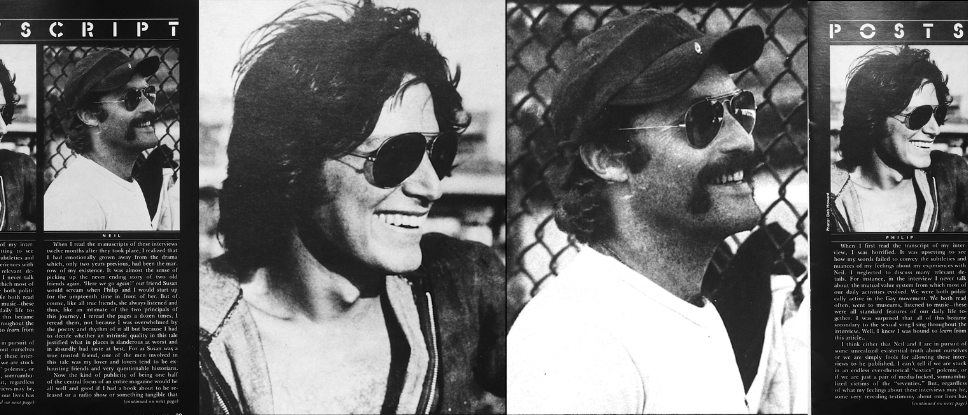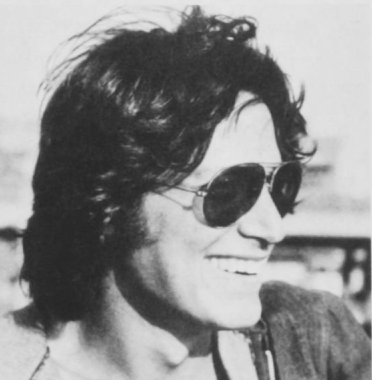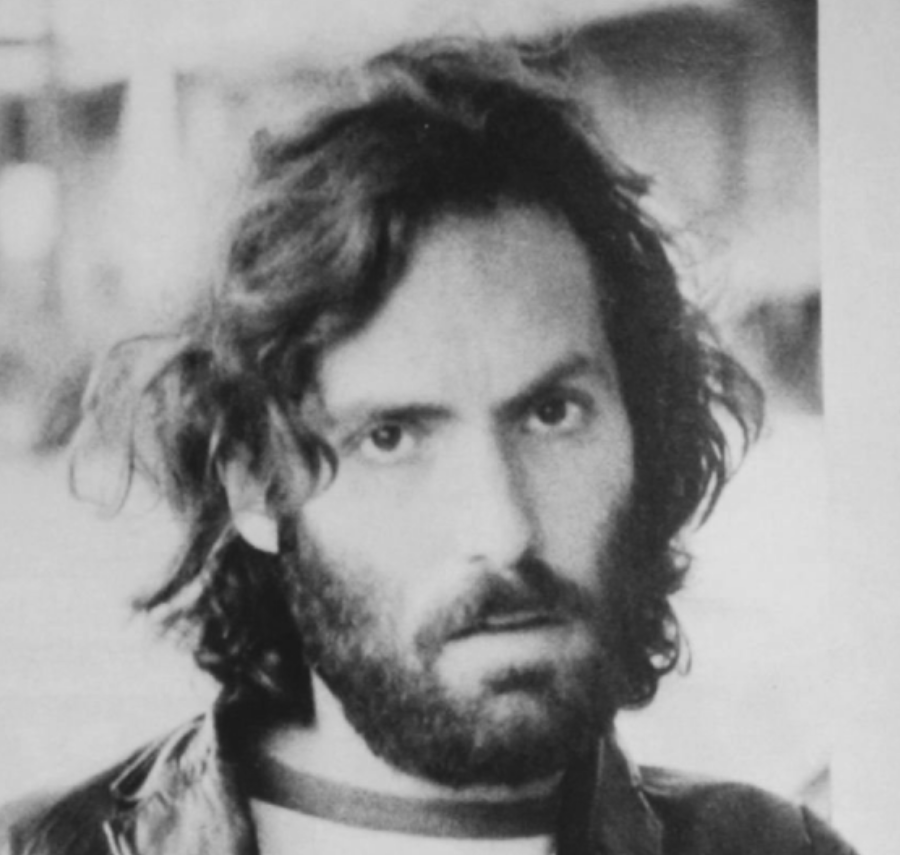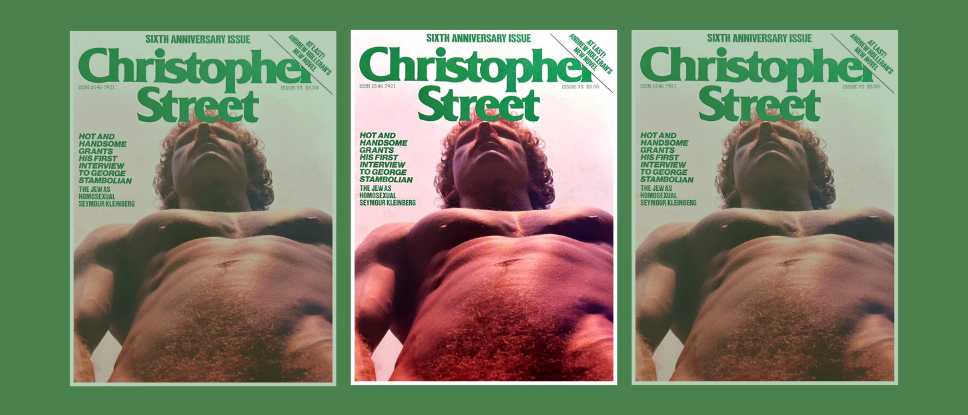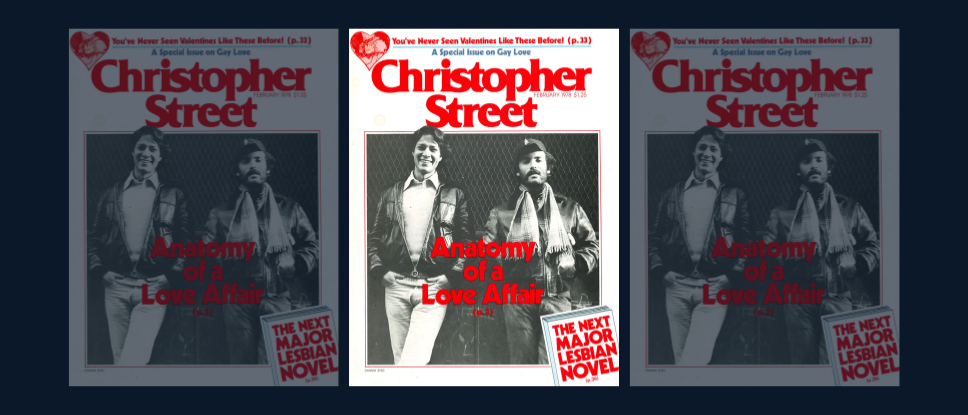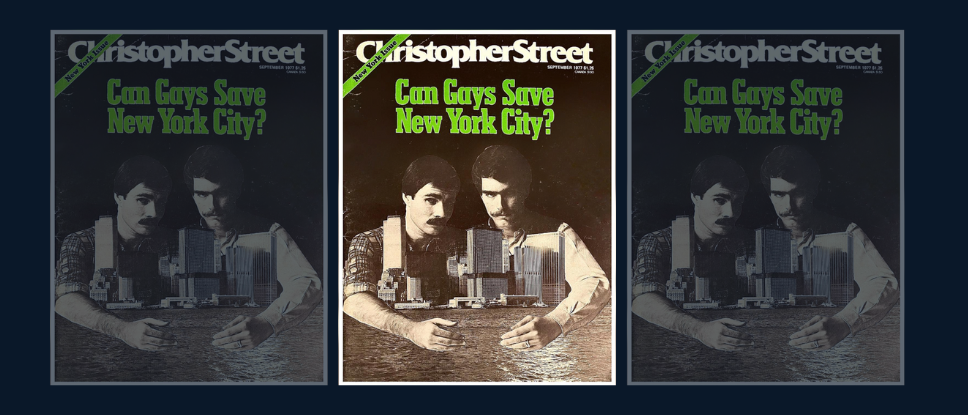This article originally appeared in the February 1978 issue of Christopher Street on pages 29-32.
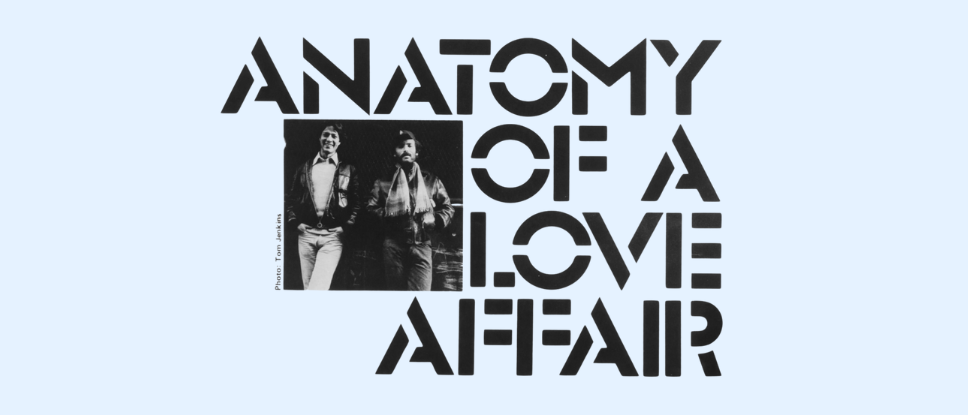
Previously in this series: Michael Denneny's introduction and interviews with Philip and Neil.
PHILIP GEFTER
When I first read the transcript of my interview, I was horrified. It was upsetting to see how my words failed to convey the subtleties and nuances of my feelings about my experiences with Neil. I neglected to discuss many relevant details. For instance, in the interview I never talk about the mutual value system from which most of our daily activities evolved. We were both politically active in the Gay movement. We both read often, went to museums, listened to music—these were all standard features of our daily life together. I was surprised that all of this became secondary to the sexual song I sing throughout the interview. Well, I knew I was bound to learn from this article.
I think either that Neil and I are in pursuit of some unrealized existential truth about ourselves or we are simply fools for allowing these interviews to be published. I can’t tell if we are stuck in an endless ever-rhetorical “sixties” polemic, or if we are just a pair of media-fucked, somnambulized victims of the “seventies.” But, regardless of what my feelings about these interviews may be, some very revealing testimony about our lives has been printed on these pages. It frightens me. It also becomes slightly absurd when I realize that it’s me in the article I’m reading, and I’m reading about someone who’s airing his proverbial dirty laundry in public. A little dirt never hurt anyone. We all know it exists, but few of us discuss it. I simply chose to discuss emotions and dynamics known by all of us, but admitted by few.
I was trained as a painter and a photographer. When I first moved in with Neil, I embarked on a photographic project which I hoped would serve as a thread of continuity throughout my lifework in photography. I began to photographically document my relationship with Neil. Soon after I began the project, Neil demanded that anytime I photograph him, he also photograph me. That seemed fair, and even appropriate. One cannot, after all, document half of a relationship. I thought that by having photographs of us both, this chronicle would be authenticated. But as the project evolved, so did the obstacles. I can now look at these three years’ worth of pictures and recognize that I didn’t grab for the camera at those most propitious moments—when we were embroiled in bitter dispute or luxuriating in utter and final bliss. I regret now that I did not have the presence of mind to photograph these moments of greatest meaning to me. The pictures which appear in this article are not necessarily the best images; they were selected because of responses evoked from Neil and me when we were looking at all the contact sheets. Those responses were taped, and provided the material for the article.
When Michael Denneny, the editor of this article, conceived the idea of “interviewing” each of us using the images as a vehicle for discussing our relationship, I liked the idea very much. There were two reasons. First, I thought it would verify the ability that photographs have to reveal things about our own lives. Secondly (and perhaps more honestly), I hoped that this article would provide me with a perspective on my feelings and perceptions about the relationship. For me, the article has succeeded in fulfilling both purposes, yet the perspective it has given me has only added to my confusion about my life with Neil.
One of the most significant points I find in both interviews is that we compare each other to our mothers. This is no accident, nor is it an idiosyncratic feature unique to our relationship. It fits yet another theory of mine about the aspects of our relationship which are, in fact, universal. The confluence of emotions summoned by any romantic involvement draws from that emotional network constructed in our most intimate early childhood attachments to our parents. Only Neil and my mother are capable of arousing primal rage in me, just as only they are capable of evoking in me those special feelings of warmth that I feel for no one else.
Since I tend to be perennially ambivalent about everything, my reactions to these interviews are no exception. I’m embarrassed at how vulnerable I am. Yet, perhaps I’m just deluding myself in thinking that it takes a great deal of strength and lots of guts to go through with this article. I feel the need to explain, rationalize and justify so many facets of the material about Neil and myself, but I’ll restrain that desire.
I guess one might read these interviews and find them as self-indulgent as I first did. But, they have given me, at least, much food for thought. More and more I realize that universals don’t lie in generalized concepts of behavior (I’m saying this?), but are manifest in the finite details in the lives of each of us. Hopefully, the dynamics and emotions we discuss will be recognizable to the reader in his or her own life.
In the year and a half since I moved out, I have established the autonomy I lacked in the relationship. During this period, I lived in Paris for a while, luxuriated at a few of the world’s more decadent playgrounds, put together an illustration portfolio, and fulfilled my romantic fantasy of working as a part-time waiter. I was in love with an Italian (apropos of Neil’s ideal fantasy type) for a few months (the rebound). Presently, I am quite content with my place in the world and my feelings about my life. I am a socially sanctioned member of the employed, working at a job which I love in the heart of the photography world. I have more confidence than ever and suffer little of the self-doubt that oppressed me while I was living with Neil. I do feel that I’m growing up.
As for Neil, we speak to each other almost daily. My feelings about him are primarily familial. He’s the most entertaining person I know, and I still truly love him. We still do dances around each other and the games we still play are, at best, amusing, and at worst, adolescent; but the hysteria is gone. Intermittently, in more needy and excessive moods, both of us fantasize a future together in some form, but, at this point, that fantasy only scares us both. Our mutual friends can’t understand why we don’t just package the relationship and put it away at last. I often wonder why myself, but the need to find the answer no longer presents itself with the urgency it once did. ❡
NEIL ALAN MARKS
When I read the manuscripts of these interviews twelve months after they took place, I realized that I had emotionally grown away from the drama which, only two years previous, had been the marrow of my existence. It was almost the sense of picking up the never-ending story of two old friends again. “Here we go again!” our friend Susan would scream when Philip and I would start up for the umpteenth time in front of her. But of course, like all true friends, she always listened and thus, like an intimate of the two principals of this journey, I reread the pages a dozen times. I reread them, not because I was overwhelmed by the poetry and rhythm of it all but because I had to decide whether an intrinsic quality in this tale justified what in places is slanderous at worst and in absurdly bad taste at best. As for Susan, who was a true trusted friend, one of the men involved in this tale was my lover, and lovers tend to be exhausting friends and very questionable historians.
Now the kind of publicity of being one half of the central focus of an entire magazine would be all well and good if I had a book about to be released or a radio show or something tangible that I was trying to sell. But I don’t. Thus, I had to deal seriously with the concept of the photo-essay as a radical departure from the standard interview as further justification for approval. Don’t get me wrong, I’m not even sure what the concept is, but along the way, I’m reminded of the old silent films—except in this model case, the dialogue is rather detailed and the viewer is asked to extend his visceral imagination. (Here too, as in the olden days, the plot is a potboiler.)
Bearing this in mind, however, I was still not quite convinced that two and a half years of my life with someone should be skewered for the sake of art and selling magazines. I think what brought me over to allowing publication of what you have seen and read is what I perceive as a desperate need in gay media for a little public honesty. One almost gets the sense with all gay periodicals that we spend as much time convincing our own people that we’re as normal as they are as we spend convincing them. Now, the obvious problem is that if we’re as normal as they are, then we’re as sick as they are, and if we’re as sick as they are, how can we be so happy practicing our unique gay lifestyles whatever in God’s name they might be. Then again, it of course struck me that I had never read an honest interview about a relationship. And since I do have this twelve-month distance, I almost simply had the gut sense that this was a no-holds-barred open-ended discourse. And from what I know, that is, having excised but two or three words at most and one photo, I concluded that if I were interested in honesty in media, then I’d have to do it myself or in any case, in concert with Philip and editor Michael Denneny.
Throughout this entire editing and rereading period, Philip was quite suspicious of my reaction. He couldn’t understand why I was not particularly emotive about the whole thing. He (and I) did not realize that I was in fact coming down with the prince of gay diseases, hepatitis. When I discovered the nature of the beast within me, I of course accused him of inseminating me with it through these manuscripts. (The disease in question has been known to lead sufferers to say even stranger things.)
Perhaps part of my non-reaction is due to a somewhat hectic year. I lost a friend at the Everard fire, was blacklisted from my radio station, was eighty-sixed from Twelve West, piloted the NYC champs RamRod who went all the way to San Francisco and back and were turned thirty. This last particular event became slightly traumatic in terms of the manuscript in that I realized that this relationship started almost five years ago. In my life at present there are two men on this coast and two on the other who, as a composite, would make an ideal lover, and who as individuals are in fact quite extraordinary human beings.
There is also Philip. It’s very odd with a former lover. I don’t know what I feel about him, what I want from him or what I want his expectations of me to be. We speak quite often on the phone but our personal interaction is much less and there are very definite reasons why. You see, once you have given your everything to someone, it is very hard to give half or to chitchat or to talk about your love life. For a long time after moving apart, Philip and I would sit over dinner for an hour or two and have nothing to say. Oh, it wasn’t that we had nothing to say; it’s just the sense of not wanting to strip down the emotions again for each other. For a long time Philip was the standard for both what I wanted and didn’t want in a man.
Everyone I met was sent through my IBM computer, which of course had Philip’s imprint, and was matched against him for intelligence quotient, beauty quotient, analytical quotient, etc. But I’ve calmed down in life. As I read what Philip wrote about me, I wonder if it was true even for him.
Oh maybe for the evening. I don’t know what to make of some of the things he says. They’re probably all true some of the time. Yet even at its worst and our worst, that relationship rang with a sonorous life that most relationships I’ve observed don’t approach. Maybe that’s the choice: a quiet long relationship with love and security or a short-lived intensity which knows neither victory nor defeat but only exhaustion.
But for all that I’ve grown, for all that I see the foibles of our growing up and eventually apart, I sometimes gaze at that photo of Philip in front of the mirror and mutter to myself, “Où sont les neiges d’antan” and “Why the hell am I going to the RamRod on a night like this?” ❡

